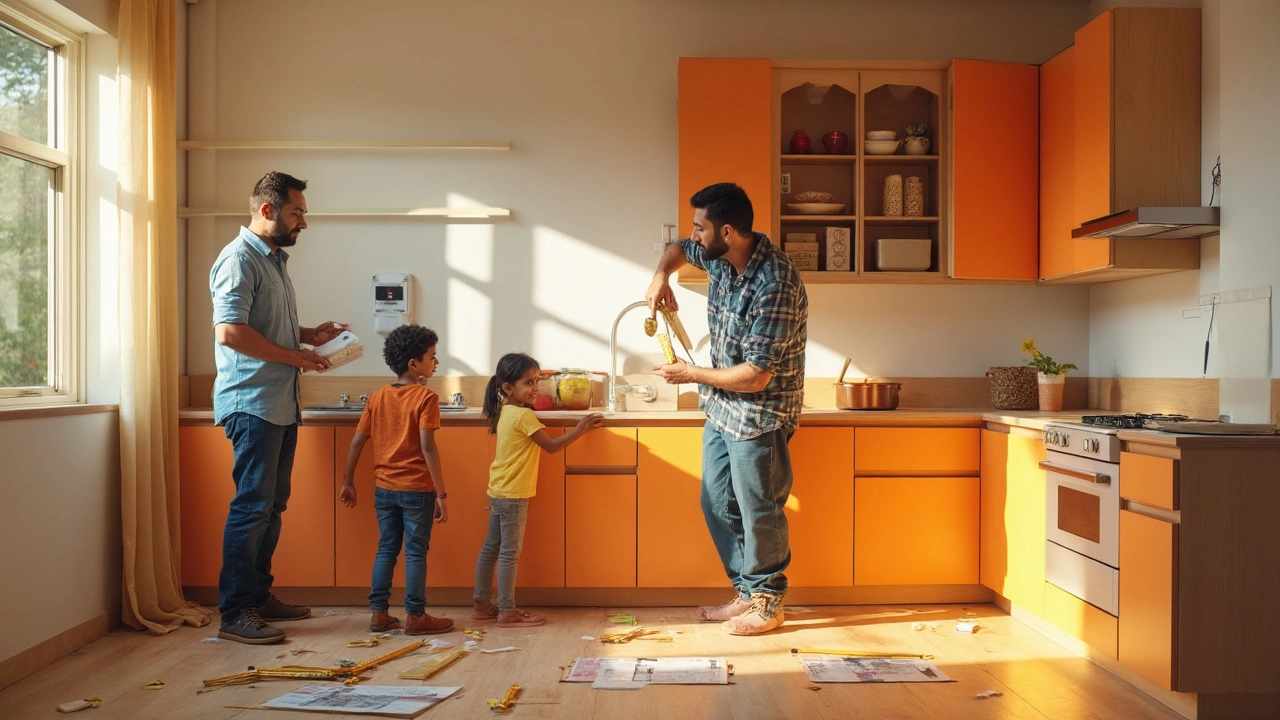Imagine spending thousands on a kitchen remodel, only to find your new oven door hits the wall or the fridge sticks out awkwardly. That’s where a dry fit kitchen comes in. Before making anything permanent, installers set up all your cabinets, appliances, and surfaces exactly where you want them—but nothing’s fixed or wired. It’s like seeing a dress on before tailoring. You get to walk around, open doors, spot awkward gaps, and make changes without regret.
Most people skip this step and end up regretting it. Dry fitting lets you check if your dream kitchen really works in your space, not just on paper. You notice little things, like the dishwasher blocking your path or the bin cupboard opening the wrong way. You deal with these annoyances before they become expensive mistakes. Already sounds smarter than just hoping for the best, right?
- What Exactly Is a Dry Fit Kitchen?
- How Dry Fitting Changes the Kitchen Game
- Common Problems It Solves (and How)
- Tips to Get the Most from Your Dry Fit
What Exactly Is a Dry Fit Kitchen?
A dry fit kitchen is basically a trial run before locking down your new kitchen installation. It means you set up the cabinets, appliances, worktops, and sometimes sinks and taps in their planned spots—just nothing is screwed, glued, or plumbed in yet. Think of it like assembling a puzzle on your table before framing it under glass. Everything looks finished, but you can still swap pieces or shift them if something feels off.
Installers usually place every part in exactly the right spot. You’ll see whether the fridge door swings open smoothly, if two drawers collide, or if there’s enough room to squeeze around the island chair. You can even check if power sockets land where you want. Dry fitting skips the guesswork and lets you avoid nasty surprises the moment the kitchen gets fully fixed and plumbed.
Here’s what’s typically included in a dry fit kitchen:
- Cabinets assembled and set in position
- Appliances slotted into their cut-outs (but not wired up)
- Worktops placed on top, not attached
- Sinks rested in place (no plumbing done yet)
- Handles and doors hung, but not screwed in forever
By the way, most pro installers or kitchen companies encourage a dry fit, especially on bigger or pricier remodels. It’s become more common since mistakes in kitchen planning usually get expensive fast. According to Which? Magazine (2023), close to 25% of homeowners wish they'd spotted layout snags before final installation—something a dry fit catches early.
If you're tackling a DIY job, this step is even more important. Lining up a dry fit gives you time to double-check every measurement, spot misalignments, and ensure your new kitchen feels right before grabbing your drill and making things permanent. The extra effort upfront saves a lot of stress—and money—later.
How Dry Fitting Changes the Kitchen Game
Having a dry fit kitchen is a game changer for kitchen installations. Instead of committing to cabinet positions, appliance slots, or worktop heights, you actually see the setup in your space before anything gets drilled or permanently fixed.
One big win? You avoid surprises. For example, let's say your original plan puts the fridge next to the oven. Dry fitting will show you if the doors crash into each other or if you can barely squeeze by. This simple check keeps you from making annoying, hard-to-fix mistakes.
Installers love dry fits because they cut down the risk of costly changes mid-installation. According to a 2023 industry survey, dry fits lead to 35% fewer on-site alterations compared to straight installs. That means less waiting around for new parts or repeat visits.
| Without Dry Fit | With Dry Fit |
|---|---|
| Multiple call-backs for adjustments | Issues spotted and tweaked up front |
| Higher risk of measurement mistakes | Cabinets/appliances checked in real time |
| Wasted materials and time | No fixing until you're happy |
Kitchen remodel experts use dry fitting for another reason: It lets you test out walking routes, storage access, and how appliances open. Think about it—you can check if you can unload the dishwasher without blocking the fridge, or if the bin pull-out isn’t behind a jammed door.
- You get a clear idea of what stays, what needs moving, and what just doesn’t work.
- It’s easier to ask for changes before any holes get drilled or stone gets cut.
- Visualizing the end result beats guessing based on a blueprint.
Instead of hoping everything fits, you guarantee it. That’s peace of mind for anyone dropping serious cash on a new kitchen installation.

Common Problems It Solves (and How)
The first big headache a dry fit kitchen can cure? Wonky measurements. Even if the plans looked fine, real rooms aren’t always straight or perfectly square. Cabinets that should line up end up with annoying gaps. Dry fitting lets you catch this before it’s too late. You can trim a panel or reshuffle things, and nobody has to start ripping anything apart.
Door and drawer clashes rank near the top of complaints after kitchen installations. Maybe the corner cabinet crashes into the dishwasher handle, or two drawers face off like stubborn rivals. With a dry fit kitchen, you open every door and drawer as if you’re using the real thing. Adjustments are simple—swap a handle, shift a hinge, or even flip the cupboard direction. No costly rework.
A biggie: appliance fit. Appliances often arrive slightly bigger or smaller than you pictured. The dry fit kitchen setup shows right away if your fridge will stick out, if the oven aligns with cabinets, or if you can actually open that giant freezer in your narrow space. That appliance “reality check” has saved homeowners from so many returns.
Utilities can trip you up, too. Maybe the plumbing is awkwardly just off the sink mark, or the power socket sits behind the microwave. With dry fitting, you see the real gaps and can adjust placements so your plumber and electrician don’t face extra work or leave you with visible wires or pipes.
Here’s a quick look at the sorts of mistakes dry-fitting can prevent and the pain they cause:
| Problem | Potential Issue Later |
|---|---|
| Misaligned Cabinets | Uneven worktops, doors won’t close right |
| Bad Appliance Fit | Doorways blocked, ugly overhangs |
| Poor Door/Drawer Spacing | Cannot open two at once, faceplate damage |
| Utility Misplacement | Extra costs, visible pipes/cables |
The thing is, fixing problems mid-install is stressful and expensive. With a dry fit kitchen, you’re basically running a rehearsal, making sure your kitchen is all set for the big show. No surprises, just a smooth install day and fewer regrets down the line.
Tips to Get the Most from Your Dry Fit
Want to make the most out of your dry fit kitchen? It’s more than just lining things up and hoping for the best. You’ll want to treat this phase like a trial run for your whole kitchen setup. Here’s how you squeeze real value out of it.
- Take your time walking through the layout. Open every door and drawer. See how things move. If something feels off, flag it now. Better to fix it now than after everything’s screwed in place.
- Double-check appliance spacing. Think about bigger appliances like your fridge or range. Can doors swing open all the way? Can two people use the kitchen without bumping into each other?
- Plug in and measure everything. Even though nothing’s hooked up permanently, you can still check if power and water points are close enough. Missed connections are a pain (and expensive) to fix after fitting.
- Bring in your must-have gadgets. Got a coffee machine or a bulky blender? Put them on the counters during the dry fit to see if you’ll actually have room for your daily routine.
- Check sight lines. Make sure you can see into rooms, outside, or wherever you want. A misplaced tall cabinet can block your favorite view, and you won’t spot it on paper plans.
According to a 2023 kitchen trends report by Houzz, more than 60% of kitchen remodelers said layout regrets were their top frustration—most of them could’ve fixed mistakes with a solid dry fit.
| Mistake | Fixed with Dry Fit? |
|---|---|
| Cabinet doors colliding | Yes |
| Appliances not fitting | Yes |
| Wrong plug locations | Yes |
| Awkward traffic flow | Yes |
Don't be shy about moving things around during this stage. If something doesn’t work, now’s your chance to swap it, shift it, or even ditch it. When the real installation begins, you’ll already know that everything fits like a glove. That’s the peace of mind you’re after in any kitchen installation or kitchen remodel.


